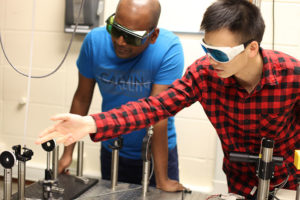Master of Nanoscience & Nanoengineering Degree Now Offered at SD Mines


RAPID CITY, SD (Aug. 13, 2018) – The South Dakota Board of Regents has approved a new master’s degree in nanoscience and nanoengineering at the South Dakota School of Mines & Technology.
These fields of science and engineering form a basis for the development of nanotechnology, focusing on understanding and manipulating matter on a scale one-hundred thousand times smaller than the diameter of a human hair.
The study of matter on these tiny scales holds immense potential for scientific and engineering breakthroughs across many areas. These include the South Dakota research and development target areas of energy and environment, human health and nutrition, and materials and advanced manufacturing. Research in Nanoscience and Nanoengineering at SD Mines complements these target areas with its emphases on electronic and photonic materials, for instance next generation solar cells; nano-biotechnology, for example live cell imaging in three dimensions using lattice light sheet microscopy or visualizing cell membrane bending with nanometer resolution; and the development of nano-composites as part of the newly announced CNAM-bio.
SD Mines already offers a Ph.D. in Nanoscience and Nanoengineering. This program has placed 25 Ph.D. graduates in academia, national laboratories and industry. The new master’s program provides an additional pathway for students to receive graduate level credentials in nanotechnology.
Increasing the state’s capacity in nanoscience and nanotechnology is important for future tech sector job growth. There is a national and international demand for skilled personnel in industry to support innovations in these fields. According to the State of South Dakota’s Science and Technology Plan, published in April 2013, these areas each experienced job growth in South Dakota from 2006-2011 that exceeded national averages. In the United States, the national labor statistics bureau reports that jobs requiring graduate level nanotechnologists are predicted to increase by nine percent in the next 10 years.
 National Science Foundation RII Track-1 Project:Expanding Research, Education and Innovation in South Dakota
National Science Foundation RII Track-1 Project:Expanding Research, Education and Innovation in South Dakota